
|   |

|   |
Mulam: Navigating through the ever-changing dynamics of Guru-Shishya relationship - Ashwini Naik e-mail: ashwini.naik.gad@gmail.com August 6, 2024 "Mulam - The roots", a festival curated and organized By Guru Vyjayanthi Kashi to celebrate the Guru-Shishya Parampara, was held this year in its 9th edition. Organized around Guru Purnima, this year saw the event held on 20th and 21st July, at Kondajji Basappa Auditorium, Bangalore. The festival was provided full support by Kannada and Culture, Govt. of Karnataka and Ministry of Culture, Govt. of India. The 2-day festival, saw young dancers and established Gurus, delve into the challenges of navigating through the Guru-Shishya relationship in this modern world. The first day was dedicated to young dancers, who have established themselves not just as renowned artistes, but also are imparting knowledge to youngsters. The panelists who spoke and performed on day 1 were Sandhya Udupa, Avijit Das, and Avani Gadre. 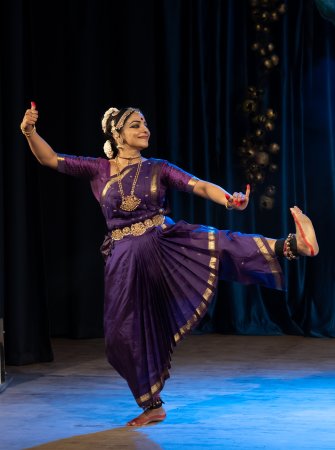 Sandhya Udupa Sandhya Udupa, who is known for her Bharatanatyam, is also trained in Kuchipudi, Yakshagana and Carnatic music, and is a trustee of the Udupa Foundation. She has trained under Gurus Chandrasekhar Navada, Vyjayanthi Kashi and acharya Indira Kadambi. She spoke on the subject, keeping her experiences with her Gurus in mind and how her relation is with the younger generation. Based on the same, she brought out multiple aspects that affect the relation today. First and foremost is the amount of time spent together has drastically reduced, as children are invested in multiple subjects and hence are now time bound. To navigate this challenge, her suggestion was that the time we have with students has to be completely dedicated to them by cutting off external distractions. Secondly, to understand why children learn dance is important, whether they learn as they love the costumes, or for the fact that they just love dance or they are passionate about it. Thirdly, the expectations have increased drastically from all involved. People come for deliverables with high expectations to get on stage or finish exams and this is also due to wrong expectations set by some dance studios. Fourth is the commitment. Commitment of a student towards art and the commitment of a Guru towards Shishya will help make the relation stronger. Finally, Samskaara or a good upbringing will ensure the student will value everything that is presented to them. As a teacher, she also considered what would help her to navigate the challenges. Here, she suggested that, being selfless, investing in further learning the art form, sharing experiences with her Gurus with the children and gaining trust from Shishya and their parents would help the teachers. As a teacher, understanding each individual and their strengths, allowing them freedom of speech but letting know their boundaries, understand the child's commitment to different classes and helping them channelize time effectively is also important. She emphasized that not every change is bad, and there are good changes too. The hierarchy between Guru-Shishya is diminishing, and relation has shifted leading to open discussions on different topics. There are different modes to stay connected that can make relations healthier and easier. As the Guru is a most prominent character in a student's life, it's important to nurture the student and discuss and sort any disagreements. Her evening performance was a Varna, choreographed by her acharya Indira Kadambi which was very beautifully performed by Sandhya. She effectively portrayed the changing emotions of a young girl, who believes that if she speaks of her worries and longing, her lord Venugopala would come to her, and hence talks to her friend of her lord describing his majestic presence and enchanting smiles and her wait for him. The energetic and intricately choreographed jatis and muktaayas were very well executed garnering applause from the audience. The varnam was in raga Amrutavarshini and adi talam. 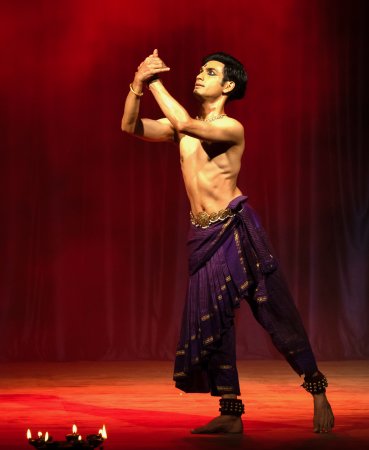 Avijit Das Avijit Das, who is a young and dynamic Kuchipudi dancer from Bangalore, and student of Guru Vedantam Ramu, was the next speaker. He believes that a Guru-Shishya Parampara requires the student's complete respect, commitment and obedience. If a student has this, he/she can fully imbibe the knowledge given. His first experience with Guru Shishya Parampara was with Kalakshetra where he spent 5 years. He said that, when you stay in such environment, you don't just learn dance, but catch on the small nuances of your Guru's style like walk, talk, which is visible in your daily activity. When he went to learn Kuchipudi under Guru Vedantam Ramu, he experienced Guru Shishya Parampara in a stronger environment as he lived in the Guru's house. Under this tradition, the learning was not just dance, but even for example, understanding costumes under different traditions. The Guru Shishya Parampara is important in not just passing dance, but also passing skill and wisdom from generation to generation. The Kuchipudi village wants to preserve this tradition and pass on all nuances of dance and tradition, the spiritual journey, craft and music. The present generation has more exposure to dance via different forums. But they are also bombarded with too many extra-curricular activities and their time is crunched. To become a professional dancer, you need to learn literature, music, and even handling social media nowadays other than dance. That's the challenge the new generation face, to navigate their time to balance their interests. Art keeps evolving and the good part is that the new generation is smart and learns fast. As part of his performance, Avijit Das presented his own choreography "Aham Bhoomi", a conversation between Bhudevi and Lord Vishnu, when she seeks his help from the clutches of demon Hiranyaksha. She reminds him of how he helped Gajendra from the crocodile, and killed the demon Madhu. She offers her surrender to the beautiful lord who also assuages the fear of learned brahmanas from the demons. The lyrics of the choreography were from Vishnu Purana and Sri Krishnaleela Tarangini, and composed in ragamalika and talamalika. Avijit stood out in his portrayal of the different characters and his choreography, especially in the Gajendra and crocodile piece. He danced on the plate with ease and grace to intricate jathis and the 5 jaathis which was well received by the audience. 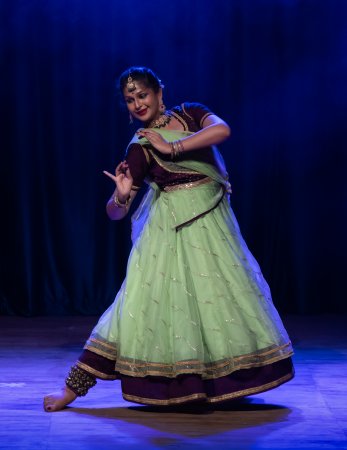 Avani Gadre The third dancer/speaker was Avani Gadre, student of Guru Shama Bhate. Speaking on the day, she believes that the relation is personal for every individual. What sets apart a Guru from teacher is that a Guru enriches disciple with knowledge, wisdom and life skills. A good student is one who is eager to learn and absorb. The relation is based on respect, trust, dedication and faith. This legacy has evolved with time. The teaching system has moved from Gurukul's set patterns to dance classes to studios, but the crux still remains the same. Her Guru constantly tests her for perfection. Her teaching methods have evolved over years, yet keeping the intensity and quality intact. Today's world the universities have enabled students from small towns to get exposed to eminent Gurus. She gave example of how her grand Guru had to use authoritative and assertive means to ensure she could get good students to grow the art, as the society wasn't open to dancing. But her Guru used intensive and rigorous approach to build strong dancers to expand scope of art. But now it's all about preservation of art. As now students have abundance of choices, she has to be creative to keep the interest of students. There is a rise in independence and individuality in students and they are open to cross question the teacher. Hence the teacher has to shed authority and take up cohesive role. Students have access to loads of content and it makes it more competitive and success oriented. Her Guru has to take the task of mentor to take up innovative approach to help students seek deep knowledge. A Guru has to create opportunities, motivate and help the students surpass themselves. Now that the education institutes provide formalized modes, students can choose Gurus from panel of teachers. The online learning modes means no physical connection, which do not let the Gurus and the Shishyas be emotionally invested. But then social media is a now major part of art and should be used to create new avenues of opportunities and collaborations for our students. She closed her talk summarizing that, even with changing times, Guru has to continue to strengthen the disciples, pushing them out of comfort zone and helping with their strong aspects. A Guru should understand own limitations and help student to grow apart from them for their betterment. As part of her performance of the evening, she started her performance with a Vandana, a dedication to divine Shakti, and followed it up with a Nritta, Taal Raas, depicting the nuances of Kathak's footwork, spins and movements and her perfection and control on the same imbibed in her by her Guru. Her next item was an abhinaya piece "Madana Dahan", showcasing her learnings of abhinaya, and then she closed her performances with a Bhajan, Muraliya Baaje, immortalized by Pandit Bhimsen Joshi. The chief guest of the first day was Prof. Dr. Nagesh Bettakotte, who is the Vice chancellor of the new established Gangubhai Hangal University of Performing Arts, and who has multiple degrees and a wide experience in drama and arts himself. Speaking to the audience, he said that it's important to create a learning foundation and framework that can help to learn art and preserve it. Art has been a core of our culture but has lacked effectiveness in the modern learning format. It's important to bring art back in education. Appreciating the idea behind Mulam, he said such festivals help in bringing the learning foundation closer to the people and should be encouraged. Art is very important to the society and the university is working hard to bring back quality to the art and its learning framework, inspite of the pushbacks and pressure being received. The first day was anchored effectively by Pragalbh and on second day, it was Dr.Lakshmi Rekha's turn. They both did justice to the important event of Guru Purnima by bringing in also their knowledge of the occasion and the arts into the process. The chief guest of the second day Dr.Vidya Rao, HOD of Department of Performing Arts and Cultural Studies, Jain (to be deemed) University, spoke of the meaning and importance of Guru as laid out by the Sanatana Dharma, and why it's important to not lose the cultural and traditional identity in the boundary of the university education. To highlight how important and valued role a Guru plays in our life, she outlined that our ancestors even named the heaviest planet in the universe as Guru (Jupiter), and the gravity which keeps us grounded was called "Guru" tvakarshana. If parents give a physical identity, the Guru gives a real-world identity. Gurus also play an important role in upholding the traditions and our culture while imparting knowledge and this important role needs to be upheld also in university education. If the first day was high on energy, the second day was an abhinaya lover's delight, with 3 exponents speaking and performing. We had Kuchipudi Guru Geeta Padmakumar, Odissi Guru Sharmila Biswas and Kathak Guru Mysore B Nagaraj gracing the occasion. 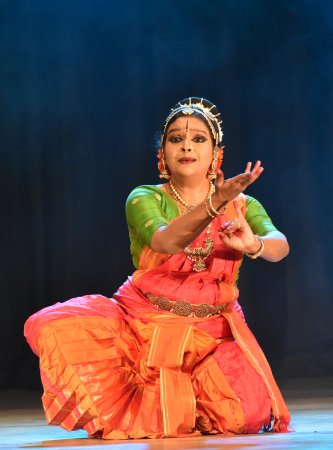 Dr. Geeta Padmakumar Dr. Geeta Padmakumar, disciple of Guru Dr. Vempati Chinna Satyam, spoke of how her Gurus instilled teachings and values in her. A Guru is someone who helps us reach a blissful mind. It starts with our parents and includes our Gurus in life. She considers her mother as her first Guru. She considers her Bharatanatyam teacher RV Shyamala as a second mother, who shaped her in dance. When she joined Dr. Vempati as student, she understood what Gurukul is. The students were put through multiple life skills like cooking in morning and managing being on time for practice, put in hard work and follow up serving what they cooked. Even though Geeta wondered why they had to do these things at the time, later in life she realized she had become good in managing multiple things at a time. Their Guru was known as a hard task master who hardly smiled or appreciated. But then he had a knack of telling a lot of things without really telling. One of the things he insisted on was to focus on learning the dance form practically, as he believed that the theory could be learnt from the available books, but the practical form can be learnt only during his lifetime to carry his legacy forward. Geeta spent one year learning only Ramayana Shabdam. He asked her why she thinks she learnt only one item for a year, and when she said the reason could be that she might not be perfect, he started teaching further. The Guru made his students retrospect and realize what they had learnt or achieved in their journey of learning. He made her learn Satyabhama by watching a video of Sobha Naidu and perform in a program. Post the performance, she was scolded by her Guru though all others appreciated. He made her understand that it's important to understand the character, be your own self in the characterization in the performance, than imitate other dancers. His scolding was celebrated by the students during those days. But today situation is different as teachers are expected to not scold the children or insist on perfection, for example with aramandi, by most parents. Though following the teachings of Master means less students, she believes in upholding the master's teachings and that it's her responsibility to carry the parampara of her Guru forward to ensure that the depth of the learning is not lost. Geeta enthralled the audience in the evening with her Kuchipudi recital. She began the evening with a Ganesh Stuti, Ananda Nartana Ganapati. She followed it with Govardhan Giridhara, a Tarangam from Sri Krishnaleela Tarangini combined with a shloka from Sri Krishna Karnamrutam. Her portrayal of the little Krishna's antics, his mother's love, the flirting with the gopis and their false anger and shyness, all added a feeling of beauty and joy to the evening. Her long but controlled performance on the brass plate, matching the rhythms, was well liked, and appreciated by the audience. 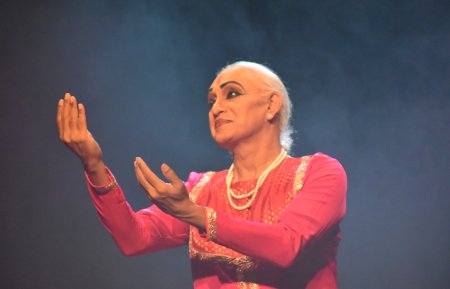 Mysore B Nagaraj Mysore B Nagaraj, a student of Gurus Tapoti Sinha, Chitra Venugopal and Maya Rao, and a famed Kathak exponent of Karnataka, spoke of his thoughts. Every artist needs 3 people to support their growth; one to feed, two to love and care, and the third to beat the artist into the groove. But a Guru is one who takes on all these roles and makes an artiste out of a person, rather than just a dancer. A Guru helps you not just learn the steps but also understand where to use them and how to use the space. Recalling his learning experience, he reminisced how he was taken for a ride and taught dance influenced by movies, in the name of Kathak. He later realized this, and in his search, he met his first Guru Tapoti Sinha who initially refused to teach him and put strong requirements around him if he still wished to learn. She finally took him in when she saw his genuine interest. She was a real Guru who went to the extreme extent of dipping her fingers in hot water to relieve herself of arthritis stiffness, to be able to teach a longing student and impart her learning. His next Guru was Maya Rao, whom he approached in his 20s. She identified that the art was already there in him, and the student just needed to be chiselled out. As a good Guru she identified his strength and started teaching him the nuances of abhinaya. She taught how to analyse the character, and get into psyche of the same, to understand the saathvikabhinaya of character, teaching to use one anga at a time in abhinaya. Today, he said that the relation is not about transfer of art and knowledge, but it's turned into a transaction. With the trend turning to teaching online with no connection between the Guru and Shishya, transferring emotion and the energy that the teacher transmits is lost. According to Nagaraj, the parampara of face-to-face and individual interaction should continue. His request was that the youngsters should learn the new things coming in but become an artist in the framework of tradition. He performed multiple abhinaya pieces for the evening showcasing the depth of his learnings. His first piece was on a creation of Nawab Wajid Ali Shah, who was in the court of Maharaja Bindadin, where the artiste calls out to Krishna, saying that all he seeks is that his body has no pain, so that he can dance and use this body as an instrument of devotion. The second piece was a Surdas bhajan, where he looks at the alternate meaning of the story of Gajendra, where Gajendra represents the man who in his thirst for wealth goes into evil waters of society, and where many crocodiles exist that will deprive him of the wealth. Third, was a Kathak piece on a Kannada Purandara Dasa composition. His bhakti-oriented compositions, where he communicated to the lord and the audience with his eyes, minimal body language really showcased how even simple movements can convey and hold the audience together. 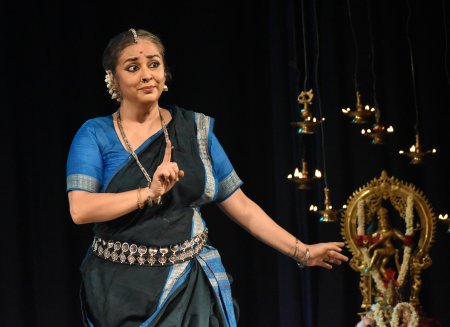 Sharmila Biswas Guru Sharmila Biswas, Odissi exponent and a prominent student of Guru Kelucharan Mohapatra, in her talk, brought out her experiences with her young students and tried analysing what they really are, and really need from their Gurus today, based on her observations during their celebration of Guru Purnima. There is a hunger for tradition in the young children and they are associating the same with dance and the Guru. The students are ready to analyse the music or dance with new eyes, and not associating with just existing traditions. There is a need in the children to be in a non-competitive space and get unconditional love from the teacher. The children do not expect their Guru to be a know-all God and accept if the teachers say they do not know something. The Gurus should open up to let them go and learn from others. Her statement, "We belong to Gharanas, not camps", summarized well the open culture needed. The children have the ability now to talk openly and have fun with the Gurus, without disrespecting them. But she raised the question in our minds, as to how much we actually communicate like in former days, purely by being closer together. The younger generation looks at God as not someone to fear. She summarized the situation today saying that students are intellectual extensions of the Gurus, and the Gurus need to also respect their efforts and their problems in life and transfer their learnings to the students. The Guru-Shishya Parampara binds us with love, honour and unlimited hunger and it's here to stay. She helped us celebrate the beautiful evening with her choreography 'Katha Surpanakha', which focused on the emotions of Surpanakha, the demoness, as a young woman, beyond the written stories. Taking inspiration from different versions of Ramayana, she brought out her hopes and desires for Rama and Lakshmana, the insult and pain when she is rejected by the two men, her anguish and anger when her nose is cut off. Though the folksy song used was in Odiya, the non-Odiya audience agreed that her abhinaya still conveyed the meaning behind the performance, and the emotional roller-coaster of the heroine of the choreography. 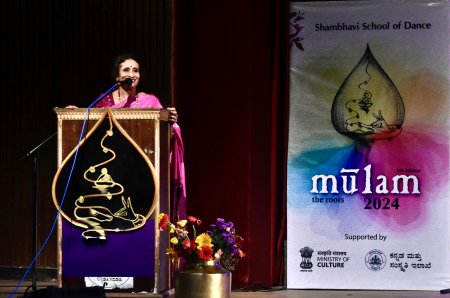 Vyjayanthi Kashi Speaking on the occasion, Guru Vyjayanthi Kashi outlined her thoughts around this important relation. When we try to understand the depth of any topic we are learning, we realise we are just a speck. When we start as a student, we should go with an innocent heart, open mind and enthusiasm to learn. As beginners when we have gained some knowledge, we wonder why our teacher isn't satisfied with what we do, and later as we learn more, we wonder why they put so much pressure on us. We think we know better and look for that appreciation. In old days, the Gurus understood this psychology of human mind and the ego involved and helped the students to remove this ego and learn better. A student learnt life principles when spending time with Gurus. It was not just about building a deep understanding of the subject, but also the values they imbibed. When they performed, they could really bring the character to life, enjoy what they did, which also transferred blissfulness to the audience. To become a Shishya of such excellence, it's important to listen, understand the art form from our Gurus who have spent time reading and building knowledge. "The process of growing from student to artist requires the student to grow from liking, to loving, to respecting or surrendering to love/bhakti, towards the teacher". Time is an important factor in crossing these stages. As also for the teacher to turn to a Guru, it's very important that they give love and time to students, and love effortlessly what they do. When a student begins his/her journey, they encounter a teacher who will impart the basics of dance; as the student learns more and starts enjoying dance, they encounter an acharya, who imparts deeper know-how of the art; but as the student builds a passion and undying hunger for the art, they encounter the Guru who takes them on the journey towards becoming an artist, opening their mind, providing all round development, building on their strengths and constructing them. Hence a Guru-Shishya relation takes a long time to grow, and communication is very important between the two to build trust. It's important for the student to understand when to communicate, what to communicate and how to communicate. It's important for the teacher to consider what the student is able to take, given her time, and emotional maturity to pass on the learnings to her. A student should also be open to take learnings beyond dance, in handling events, music, stage as a wholesome experience. Having a feeling of family with the class and teacher where they are learning, will help them to be more open minded to the learnings they receive based on their strengths. Today, with the smaller number of hours spent together with the Guru, most of what the students listen, can get nullified in other environments and the influence of surrounding people. It's important that students try and understand the deeper meaning of the Guru-Shishya relation. Even reciting "Guru Brahma Guru Vishnu ", has become mechanical. Summarizing the whole event, Vyjayanthi Kashi requested the audience to understand the shloka, and only then can you begin to respect it, and live the teachings of the Gurus. 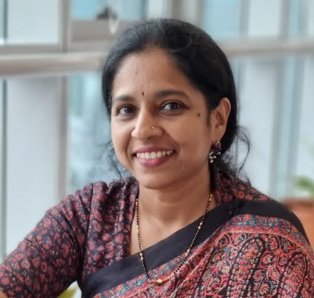 Ashwini Naik is a corporate leader, dance enthusiast and an amateur writer. Vice President in a Multinational, Ashwini tries to intertwine her vocation and avocation by driving cultural initiatives in the corporate world. Having trained in Bharatanatyam and Kuchipudi, Ashwini shares her learnings of leadership qualities from dance with her corporate friends. |